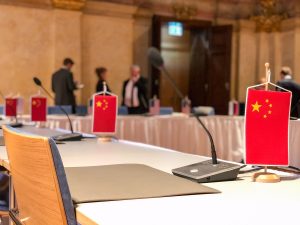Delegations from the United States and Russia met in Vienna on Monday for nuclear arms control talks. At the onset of the talks, Marshall S. Billingslea, the U.S. special presidential envoy for arms control, posted a photograph on Twitter of four Chinese national flags on a table, with American and Russian flags visible in the background.
“Vienna talks about to start,” Billingslea said in his tweet. “China is a no-show. Beijing still hiding behind #GreatWallofSecrecy on its crash nuclear build-up, and so many other things. We will proceed with #Russia, notwithstanding,” he added. To an uninitiated reader, the image—along with Billingslea’s use of “no show”—might have implied that China had accepted an invitation, but failed to send a delegation.
Nothing could be further from the truth.
Despite Billingslea and U.S. President Donald Trump’s exhortations that China needs to join U.S.-Russia strategic arms control talks, Beijing has shown no interest. China has said that it would only join such talks once the United States and Russia’s nuclear forces were on par with its smaller total force size, which stands at around 300 total warheads (versus more than a thousand deployed warheads each for the United States and Russia).
Twitter has recently become more prominent in the Chinese public diplomacy toolkit so it was perhaps unsurprising that Fu Cong, director general in the Department of Arms Control in the Chinese Ministry of Foreign Affairs, replied to Billingslea.
What an odd scene! Displaying Chinese National Flags on a negotiating table without China's consent!
Good luck on the extension of the New START!
Wonder how LOW you can go?— Fu Cong 傅聪 (@FuCong17) June 22, 2020
Billingslea’s odd display raised some questions. For instance, did the Russian side agree to this photo op (including the placement of a third country’s national flags)? Did the U.S. side bring these flags? Russian journalist Elena Chernenko at Kommersant reported that the Russian side “objected to Chinese flags in the absence of Chinese.” That meant the “US made this pic and then removed ALL flags before the meeting started,” she added.
This stunt in Vienna is unlikely to be persuasive with Beijing. The Trump administration’s related argument — that it would seek to turn world opinion against China should it refuse to show up to arms control talks—also does not appear to hold water. Instead, among American allies, calls to extend the 2010 New Strategic Arms Reduction Treaty (New START) for another five years remain strong.
The administration continues to hold that argument hostage to Chinese participation in negotiations (and separate issues related to Russia). It still remains unclear whether New START will be extended, but it’s clear that Billingslea and the Trump administration are far from serious in their efforts to actually begin a necessary, good faith process of talking to China about strategic stability matters that could, one day, open the door to a broader discussion on conventional and nuclear arms control.

































